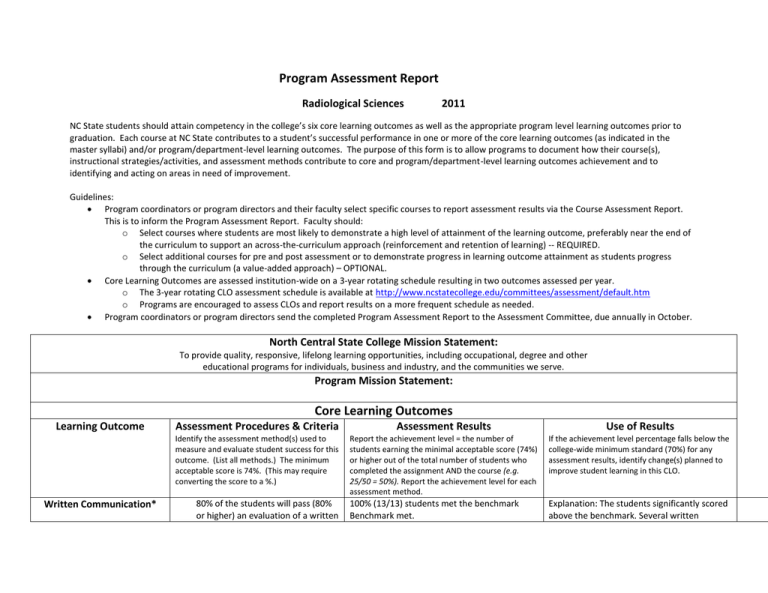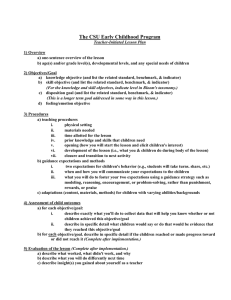Program Assessment Report Radiological Sciences 2011
advertisement

Program Assessment Report Radiological Sciences 2011 NC State students should attain competency in the college’s six core learning outcomes as well as the appropriate program level learning outcomes prior to graduation. Each course at NC State contributes to a student’s successful performance in one or more of the core learning outcomes (as indicated in the master syllabi) and/or program/department-level learning outcomes. The purpose of this form is to allow programs to document how their course(s), instructional strategies/activities, and assessment methods contribute to core and program/department-level learning outcomes achievement and to identifying and acting on areas in need of improvement. Guidelines: Program coordinators or program directors and their faculty select specific courses to report assessment results via the Course Assessment Report. This is to inform the Program Assessment Report. Faculty should: o Select courses where students are most likely to demonstrate a high level of attainment of the learning outcome, preferably near the end of the curriculum to support an across-the-curriculum approach (reinforcement and retention of learning) -- REQUIRED. o Select additional courses for pre and post assessment or to demonstrate progress in learning outcome attainment as students progress through the curriculum (a value-added approach) – OPTIONAL. Core Learning Outcomes are assessed institution-wide on a 3-year rotating schedule resulting in two outcomes assessed per year. o The 3-year rotating CLO assessment schedule is available at http://www.ncstatecollege.edu/committees/assessment/default.htm o Programs are encouraged to assess CLOs and report results on a more frequent schedule as needed. Program coordinators or program directors send the completed Program Assessment Report to the Assessment Committee, due annually in October. North Central State College Mission Statement: To provide quality, responsive, lifelong learning opportunities, including occupational, degree and other educational programs for individuals, business and industry, and the communities we serve. Program Mission Statement: Core Learning Outcomes Learning Outcome Written Communication* Assessment Procedures & Criteria Assessment Results Use of Results Identify the assessment method(s) used to measure and evaluate student success for this outcome. (List all methods.) The minimum acceptable score is 74%. (This may require converting the score to a %.) Report the achievement level = the number of students earning the minimal acceptable score (74%) or higher out of the total number of students who completed the assignment AND the course (e.g. 25/50 = 50%). Report the achievement level for each assessment method. If the achievement level percentage falls below the college-wide minimum standard (70%) for any assessment results, identify change(s) planned to improve student learning in this CLO. 100% (13/13) students met the benchmark Benchmark met. Explanation: The students significantly scored above the benchmark. Several written 80% of the students will pass (80% or higher) an evaluation of a written assignment in RAD 236 using the Writing Across the Curriculum (WAC) rubric. Speech* 80% of the students will pass (75% or higher) an evaluation of an oral presentation in RAD 236 using the Speech Across the Curriculum (SpAC) rubric 93% (13/14) students met the benchmark. Benchmark met assignments were given prior to the essay which is the tool for measuring this bench mark. Specific guidelines were given for these small written assignments which then lead to much higher scores on the RAD 236 essay. No change needed Information Literacy* Critical Thinking* 75% of the 1st year students will pass (75% of higher) the “Think It Through” component of the RAD Procedures classes 142-144. RAD 142 67% (10/15) Benchmark not met. Prior to RAD 143, lab assignments given throughout the quarter were developed to better align with the “Think It Through” assessment. (rubric) RAD 143 86% (12/14) Benchmark met. RAD 144 85% (11/13) Benchmark met Intercultural Knowledge/Competence* Computation Proficiency** *Rubrics are available on the Assessment of Student Learning Committee web site at http://www.ncstatecollege.edu/committees/assessment/default.htm. These rubrics may be used as is or modified, or another rubric or assessment method may be substituted. **After semester conversion, programs should report assessment results from the highest college math course in the curriculum (comprehensive final exam scores) as well assessment results that occur in non-math program courses where computation is considered to be important to the technology/profession (e.g. drug calculations in a nursing curriculum). Program-Level Learning Outcomes (add rows as needed) Learning Outcome Assessment Procedures & Criteria Assessment Results Use of Results Enter outcomes below; add rows as needed. Identify the assessment method(s) used to measure and evaluate student success for this outcome. (List all methods.) State the Report the achievement level = the number of students attaining the minimum acceptable score or higher out of the total number of students who If the achievement level percentage falls below the program’s minimum standard for any assessment results, identify change(s) planned to improve The graduate will demonstrate professional attitudes, behaviors and ethics. minimum acceptable score for each method. completed the assignment AND the course (e.g. 25/50 = 50%). State the program’s minimum achievement level percentage and report the achievement level attained for each assessment method. student learning in this learning outcome. 75% of the first year students will obtain an average score of 60/80 points on the following sections of the Mid-quarter CI evaluation: II A, B, C IV-VI X 100% (12/12) students met the benchmark. Benchmark met. No action required 75% of second year students will obtain an average score of 68/80. 54% (7/13) students met the benchmark. Benchmark not met. Explanation: Review of data indicated above average tardiness and absenteeism. Also students in this class scored lower in initiative and response to authority and direction. 100% (3/4 - Excellent 1/4 - Good) Benchmark met No action required 50% of the graduate respondents will join a professional organization. 75% (3/4) ASRT 75% (3/4) OSRT Will continue to emphasize the importance of not only belonging to a professional organization but to also become involved in the organization 75% of the graduate respondents who seek employment in the radiology field will be employed within 6 months following graduation. 75% (3/4) Benchmark met No action 75% of the employer respondents will rate graduates as average or higher in demonstrating professional attitudes, behaviors and ethics. The program will assure that it meets the needs of the health care community, and the curriculum reflects the current practices of the profession 75% of the employer respondents will indicate that the employer would hire future graduates from the program. 100% (4/4) Benchmark met No action The graduates “Mean Sections Scaled Scores” on the ARRT examination will be equal to or greater than the national average. National Mean Score = 84.9 2010 Graduate Mean Score = 88.3 Benchmark met No action 68% (13/19) Benchmark not met Beginning with June, 2012 all students will enter program in a competitive process. 100% (4/4) No action 100% (3/4 - Excellent 1/4 - Good) No action 75% of the students starting the program will complete the program. The graduate will be competent as an entry-level radiographer. 75% of the employer respondents will indicate that the graduate was adequately prepared as an entrylevel practitioner. 75% of the graduates respondents will indicate that they were adequately prepared to perform as an entry-level practitioner (average or higher).



